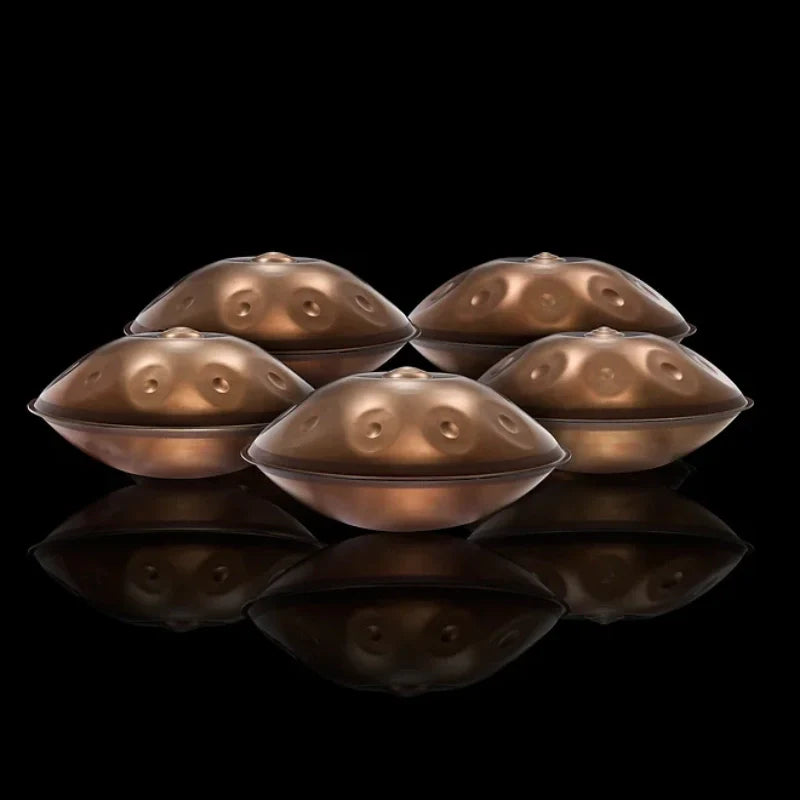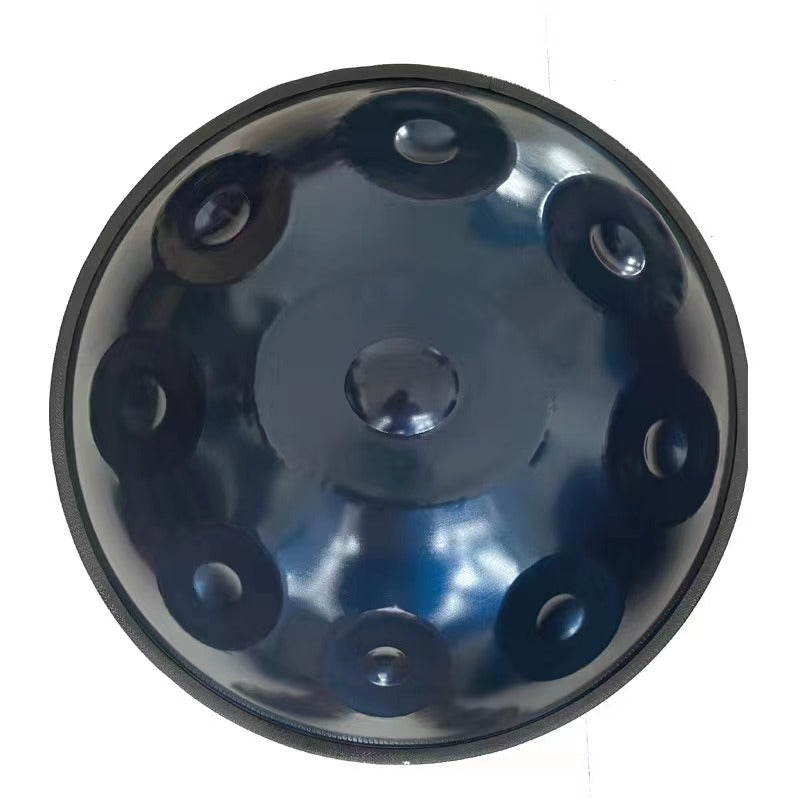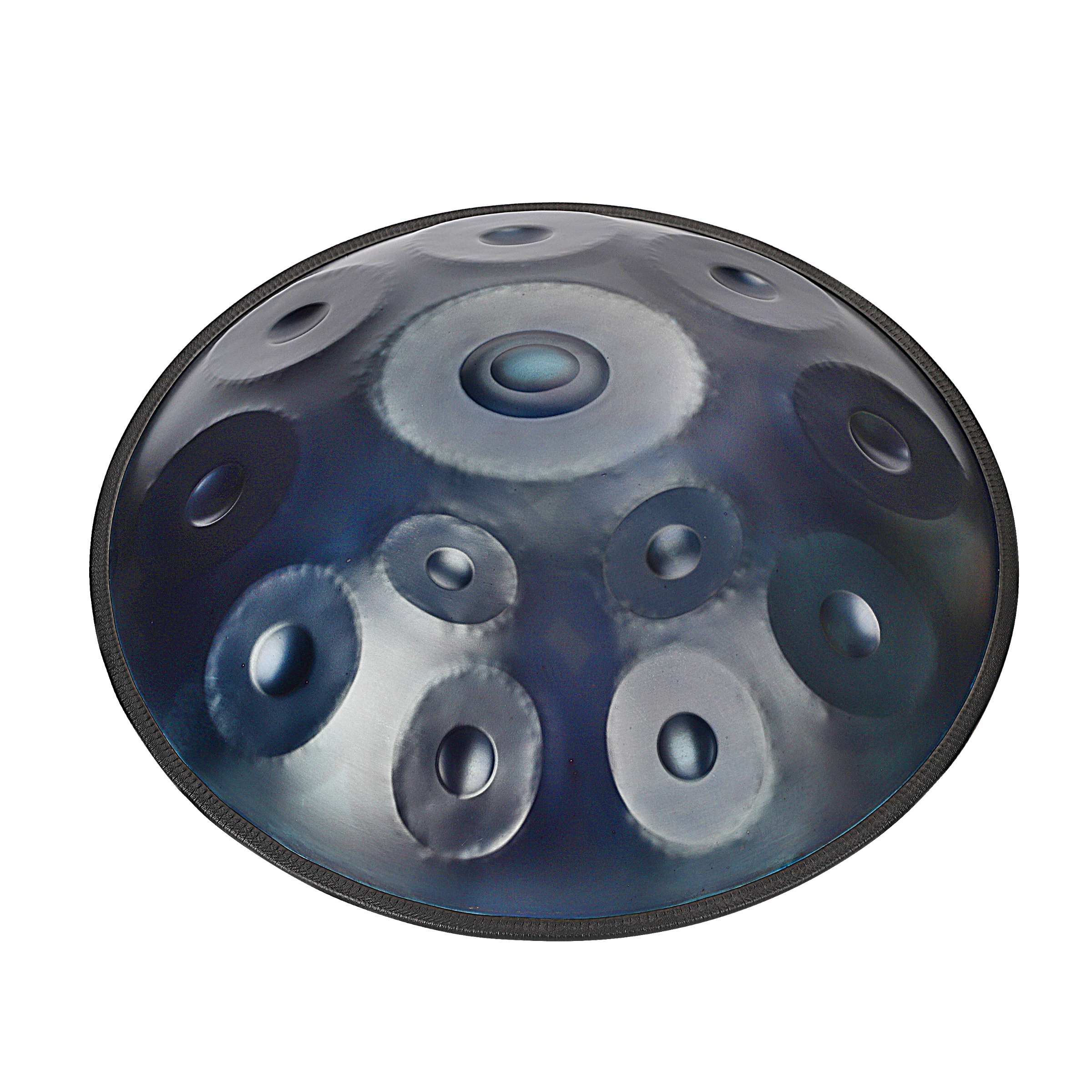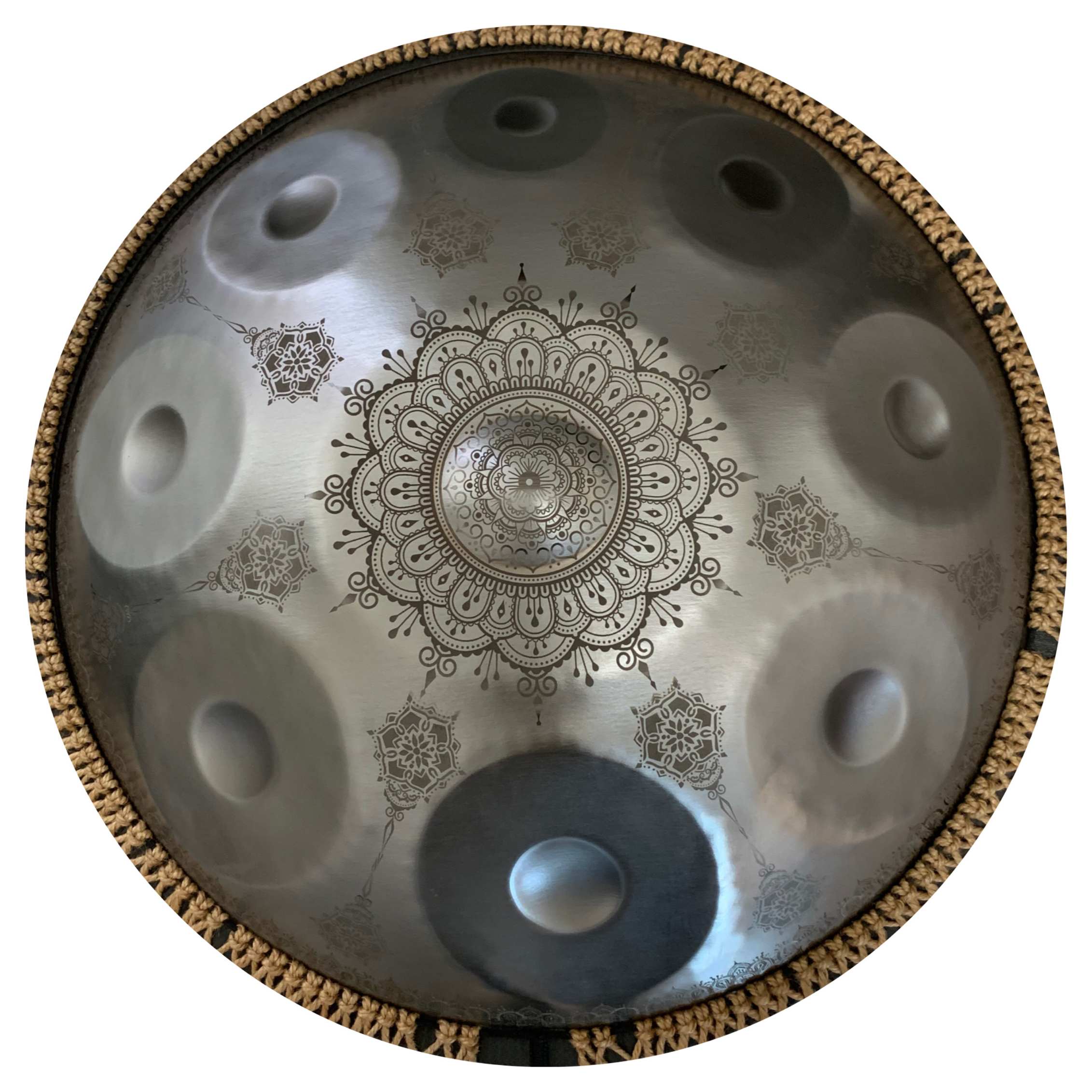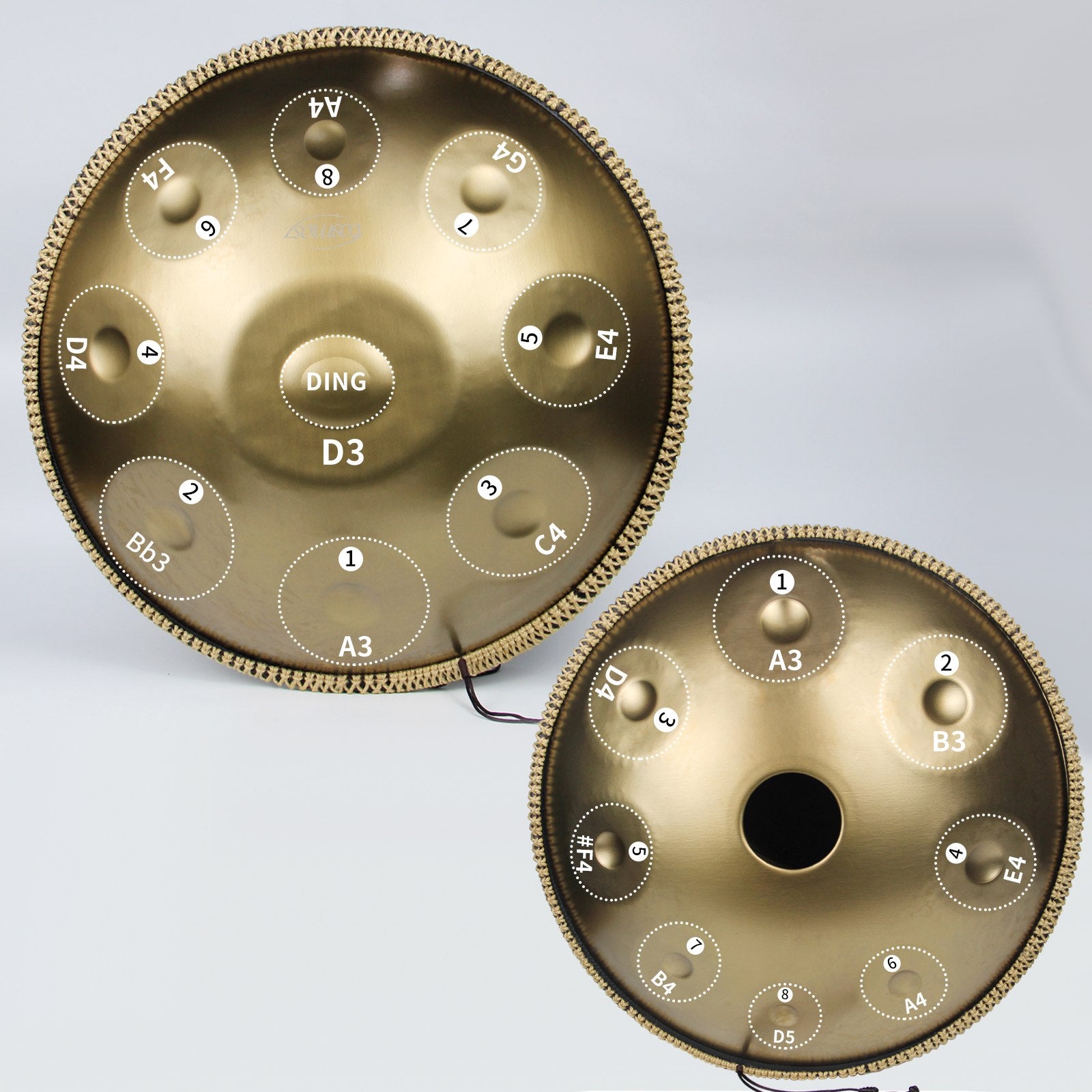Entfesseln Sie das volle Potenzial Ihres Handpan-Durms mit Experten-Tipps zu Technik, Auswahl der Skalen, Wartung und mehr in diesem umfassenden Leitfaden.

Das Handpan ist ein einzigartiges Schlaginstrument, das in letzter Zeit aufgrund seines ungewöhnlichen Klangs und seiner Anpassungsfähigkeit an Popularität gewonnen hat. Handpans stammen von der Trinidad Steel Pan ab. Ursprünglich von einem einzigen Unternehmen in der Schweiz hergestellt, gibt es jetzt über 100 Handpan-Unternehmen weltweit.
Das Handpan wird oft mit einem Stahlpan verglichen, obwohl es einen sanfteren und melodischeren Klang erzeugt. Es wird gespielt, indem man die kuppelförmige Oberfläche mit den Händen anschlägt, was einen reichen und nuancierten Klang erzeugt.
In diesem Artikel werden wir 10 Tipps betrachten, um das Beste aus deinem Handpan-Drum herauszuholen und deine Handpan-Fähigkeiten zu verbessern. Diese Tipps werden dir helfen, deine Technik zu verfeinern, deinen musikalischen Wortschatz zu erweitern und ein besseres Verständnis für die Handpan zu gewinnen.
1. Wählen Sie ein qualitativ hochwertiges Handpan
Bevor Sie eine Handpan kaufen, führen Sie eine gründliche Recherche durch. Besuchen Sie Festivals, fragen Sie Handpan-Freunde, posten Sie einen Aufruf in Foren für lokale Spieler und/oder kontaktieren Sie renommierte Hersteller, um einen Besuch zu vereinbaren. Eine anständige Handpan sollte selbst für Anfänger leichter zu spielen und zu verstehen sein. Die sieben Hauptmerkmale einer guten Handpan sind:
- Stimmung: Die Genauigkeit und Konsistenz der Töne über das Handpan.
- Färbung: Die einzigartige Klangqualität und Fülle des Instruments.
- Nachhaltigkeit: Wie lange der Klang nach jedem Schlag nachhallt.
- Balance: Die Gleichmäßigkeit und Kohärenz des Klangs zwischen verschiedenen Tönen.
- Kein Übersprechen: Minimale Interferenz oder unbeabsichtigte Resonanz zwischen benachbarten Noten.
- Dynamikbereich: Die Fähigkeit des Handpans, ein breites Spektrum an Lautstärken und Intensitäten zu erzeugen.
- Harmonische Präzision: Die Klarheit und Reinheit der harmonischen Obertöne, die das Instrument erzeugt.
Nehmen Sie sich Zeit, genießen Sie es und untersuchen Sie es, während Sie alle Attribute berücksichtigen.
2. Wählen Sie die richtige Handpan-Skala
Wenn Sie Ihr Abenteuer mit dem Handpan beginnen, ist die Wahl der richtigen Skala entscheidend für Ihr Vergnügen und Ihre kreative Ausdrucksweise. Beginnen Sie damit, zahlreiche Handpan-Skalen auf Plattformen wie YouTube zu erkunden, wo Sie verschiedene Alternativen anhören und Notizen darüber machen können, welche Ihnen gefallen. Berücksichtigen Sie die Eigenschaften jeder Skala – moll, dur, ernst, scharf, sanft oder beschwingt – und deren Fähigkeit, Ihre musikalischen Ziele zu unterstützen, sei es beim Jammen, Schreiben, Entspannen oder beim Verbessern Ihres aktuellen Setups. Um Ihre Vorlieben erfolgreich an Handpan-Hersteller zu kommunizieren, listen Sie Ihre Lieblingsskalen mit bestimmten Merkmalen wie Namen und musikalischen Noten auf.
Die Recherche und Kontaktaufnahme mit Herstellern bezüglich der Verfügbarkeit von Skalen ist entscheidend, da nicht alle Hersteller jede Skala produzieren. Seien Sie bereit, aus den verfügbaren Möglichkeiten auszuwählen oder alternative Hersteller zu prüfen, die auf Ihre ausgewählte Skala spezialisiert sind. Nehmen Sie sich Zeit bei der Entscheidungsfindung, um sicherzustellen, dass sie mit Ihren musikalischen Zielen und Vorlieben übereinstimmen. Indem Sie diese Verfahren befolgen, können Sie mit Zuversicht eine Handpan-Skala wählen, die Ihren musikalischen Anforderungen entspricht und stark mit Ihrer künstlerischen Vision und Ihrem Stil verbunden ist.
3. Schauen Sie sich Videos an
Um dein Gehör für Handpan-Musik zu verfeinern, beginne damit, "Handpan" auf YouTube zu suchen und verschiedene Videos anzuhören. Verwende Kopfhörer für eine bessere Klarheit, um Nuancen wie Ton, Sustain, Stimmung, Notenbalance und Dynamik wahrzunehmen. Achte auf die Unterschiede zwischen den Instrumenten, die du hörst.
Wenn Sie sich auf das Zuhören einstellen, werden Sie Instrumente identifizieren, die mit Ihnen resonieren. Wenn Sie mehr Videos ansehen, werden Sie trainiert, zwischen hochwertigen Klängen und solchen, die wie Töpfe klingen, zu unterscheiden. Denken Sie daran, dass Aufrufe und Likes manchmal die Qualität von Instrumenten anzeigen können, aber beliebte Videos auch Tricks wie ungewöhnliche Spieltechniken zeigen können.
4. Verstehe das Handpan
Bevor Sie mit den Techniken fortfahren, müssen Sie zunächst ein grundlegendes Verständnis des Handpans erlangen. Es handelt sich um eine konvexe Stahldrum mit vielen Tonfeldern und einem dingartigen Zentrumston. Das Instrument wird gespielt, indem Sie die verschiedenen Tonabschnitte mit Ihren Handflächen und Fingern berühren. Jedes Tonfeld erzeugt einen kohärenten und musikalischen Klang mit seiner eigenen charakteristischen Tonhöhe. Machen Sie sich mit dem Design und den Tönen des Handpans vertraut, um eine stärkere Verbindung zu ihm aufzubauen.
5. Meistere rhythmische Muster
Jede musikalische Komposition basiert auf Rhythmus, und das Handpan ist da keine Ausnahme. Beginne mit dem Üben grundlegender Vier- und Sechs-Schlag-Rhythmen sowie zusätzlicher einfacher Rhythmusmuster. Ein Metronom kann dir helfen, dein Zeitgefühl und deine Präzision zu verbessern. Fordere dich im Laufe der Zeit mit schwierigeren Mustern, Synkopen und Polyrhythmen heraus. Versuche, Tempi und Akzente in deinen Handpan-Kompositionen zu variieren, um Tiefe und Komplexität hinzuzufügen.
6. Erkunde melodische Vielfalt auf dem Handpan
Während der Rhythmus entscheidend ist, bietet das Handpan auch verschiedene melodische Optionen. Experimentiere mit verschiedenen Skalen und Modi, um faszinierende Melodien zu kreieren. Beginne damit, die pentatonische Skala zu lernen, die oft in Handpan-Musik verwendet wird. Wenn du mehr Selbstvertrauen gewinnst, experimentiere mit exotischeren Skalen wie der dorischen, phrygischen und mixolydischen. Kombiniere melodische Sequenzen und rhythmische Muster, um komplexe und ausdrucksstarke musikalische Phrasen zu erzeugen.
7. Sauberkeit ist der Schlüssel
Alle Bühnenmusiker, die gut auf ihre Instrumente achten, reinigen sie mit einem Tuch, bevor sie sie verstauen. Stahl ist ein poröses Material, das alles aufnimmt, was sich darauf befindet. Finger und Hände sind häufig fettig von Körperölen, schmutzig und haben die unglückliche Angewohnheit, abgestorbene Zellen zurückzulassen. Der Schmutz hat sich auf deinem Handpan angesammelt, was nicht ideal ist. Es ist immer am besten, ein Mikrofasertuch in der Tasche zu haben, um die Oberfläche nach jeder Spielsitzung zu reinigen. Gewöhne dir an, dies zu tun, und diszipliniere dich.
8. Spielen in feuchten Orten
Das Spielen deines Handpans am Strand während der magischen Stunden von Sonnenaufgang oder Dämmerung kann unglaublich inspirierend sein. Der beruhigende Klang der Wellen und die Wärme einer Sommerbrise schaffen eine ideale Umgebung für musikalische Kreativität. Es gibt jedoch wichtige Überlegungen, die man im Hinterkopf behalten sollte.
Die hohe Luftfeuchtigkeit und die Salzeinwirkung in der Nähe des Meeres können Ihrem Handpan schaden. Salz, das dafür bekannt ist, Korrosion zu verursachen, kann das Instrument im Laufe der Zeit beschädigen, wenn es nicht richtig behandelt wird. Nach dem Spielen ist es entscheidend, Ihr Handpan abzuwischen, um Feuchtigkeit zu entfernen und es vor salziger Luft zu schützen, indem Sie es sicher in seinem Koffer aufbewahren.
Zusätzlich zieht das Spielen am Strand oft die Aufmerksamkeit von Passanten auf sich, die neugierig auf den einzigartigen Klang des Handpans sind. Während Gespräche angenehm sein können, ist es wichtig, dein Instrument niemals unbeaufsichtigt zu lassen, insbesondere in verletzlichen Zeiten wie der Dämmerung oder am frühen Morgen. Dein Handpan in seinem Koffer zu sichern, wenn es nicht in Gebrauch ist, gewährleistet seine Sicherheit und Langlebigkeit, sodass du deine musikalischen Strand-Sessions ohne Sorgen genießen kannst.
9. Richtige Handplatzierung und Haltung
"Sie müssen eine richtige Handplatzierung und Haltung entwickeln, um das Handpan effizient zu spielen. Das Handpan wird mit den Händen gespielt, und eine richtige Technik ist erforderlich, um einen klaren und konstanten Klang zu erzeugen. Die Hände sollten in einer entspannten und natürlichen Position auf dem Instrument platziert werden, mit den Fingern gekrümmt und den Handflächen nach unten gerichtet. Die Haltung sollte aufrecht und entspannt sein, mit geraden Schultern, Armen und Rücken. Eine richtige Handplatzierung und Haltung ermöglichen es Ihnen, das Handpan komfortabler und effizienter zu spielen."
10. Üben Sie regelmäßig
Schließlich ist regelmäßiges Üben entscheidend für das Erlernen des Handpan, da es Technik, Timing und die allgemeine Musikalität verbessert. Durch kontinuierliches Üben wirst du ein tieferes Verständnis für das Instrument und seine Möglichkeiten gewinnen, was es dir ermöglicht, mit neuen Ansätzen und Stilen zu experimentieren. Darüber hinaus fördert häufiges Üben das Muskelgedächtnis, wodurch das Spielen komplexer Muster und Rhythmen einfacher wird.
Abschluss
Um im Spielen des Handpan hervorragend zu sein, müssen Sie die Geduld, Hingabe und Neugier haben, um die einzigartigen Eigenschaften des Instruments zu entdecken. Das Beherrschen der Handplatzierung, des Rhythmus, der Melodie und der Dynamik ist entscheidend, um einen persönlichen Stil zu entwickeln und fesselnde Musik zu kreieren. Denken Sie daran, oft zu üben, neue Methoden auszuprobieren und sich von erfahrenen Handpan-Spielern inspirieren zu lassen. Mit der Zeit und Arbeit werden Sie das volle Potenzial dieses wunderbaren Instruments erkennen und das Publikum mit Ihrer Handpan-Musik fesseln.

